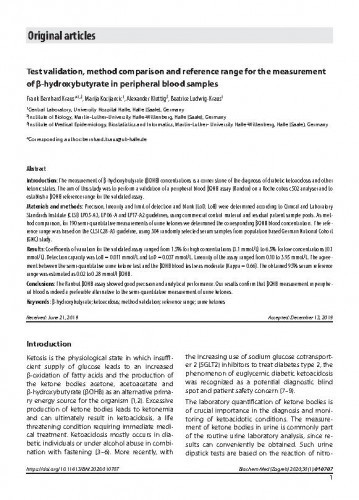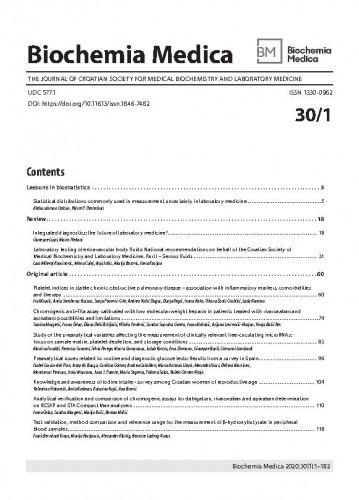Introduction: The measurement of β-hydroxybutyrate (βOHB) concentrations is a corner stone of the diagnosis of diabetic ketoacidosis and other ketonic states. The aim of this study was to perform a validation of a peripheral blood βOHB assay (Randox) on a Roche cobas c502 analyser and to establish a βOHB reference range for the validated assay.Materials and methods: Precision, linearity and limit of detection and blank (LoD, LoB) were determined according to Clinical and LaboratoryStandards Institute (CLSI) EP05-A3, EP 06-A and EP17-A2 guidelines, using commercial control material and residual patient sample pools. As method comparison, for 190 semi-quantitative measurements of urine ketones we determined the corresponding βOHB blood concentration. The reference range was based on the CLSI C28-A3 guideline, using 304 randomly selected serum samples from population based German National Cohort (GNC) study.Results: Coefficients of variation for the validated assay ranged from 1.5% for high concentrations (3.1 mmol/L) to 6.5% for low concentrations (0.1 mmol/L). Detection capacity was LoB = 0.011 mmol/L and LoD = 0.037 mmol/L. Linearity of the assay ranged from 0.10 to 3.95 mmol/L. The agreement between the semi-quantitative urine ketone test and the βOHB blood test was moderate (Kappa = 0.66). The obtained 95% serum reference range was estimated as 0.02 to 0.28 mmol/l βOHB.Conclusions: The Ranbut βOHB assay showed good precision and analytical performance. Our results confirm that βOHB measurement in peripheral blood is indeed a preferable alternative to the semi-quantitative measurement of urine ketones.
Sažetak

 Biochemia medica : the journal of Croatian Society for Medical Biochemistry and Laboratory Medicine : 30,1(2020) / glavna i odgovorna urednica Daria Pašalić.
Biochemia medica : the journal of Croatian Society for Medical Biochemistry and Laboratory Medicine : 30,1(2020) / glavna i odgovorna urednica Daria Pašalić.